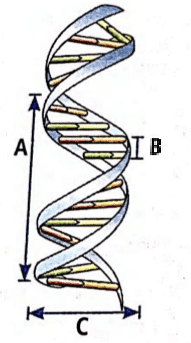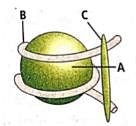Test: The DNA (NCERT) - NEET MCQ
15 Questions MCQ Test Biology Class 12 - Test: The DNA (NCERT)
Choose the correct answer from the alternatives given :
Given figure represents the DNA double helix model is proposed by Watson and Crick (1953). Select the option that shows correct measurements of A, B and C.

Given figure represents the DNA double helix model is proposed by Watson and Crick (1953). Select the option that shows correct measurements of A, B and C.

| 1 Crore+ students have signed up on EduRev. Have you? Download the App |
Refer the given figure of nucleosome and select the option that correctly identifies the parts A, B and C.




If a double stranded DNA has 20% of cytosines, calculate the percent of adenine in the DNA.
How is the long DNA polymer packaged in a prokaryotic cell like E. coli?
If the sequence of bases in one strand of DNA is ATGCATGCA, what would be the sequence of bases on complementary strands?
Read the following statements and select the Correct option.
(i) Loosely packed and lightly stained region of chromatin are called as heterochrormatin.
(ii) Densely packed and dark stained region of chromatin are called as euchromatin.
(iii) A typical nucleosome contains 200 bp of DNA helix.
Chemically, RNA is (i) reactive and (ii) stable as compared to DNA.
In a DNA strand,the complementary base pairs are linked togther by?
Which of the following statements is true regarding the hydrogen bonds in DNA base pairing?
Which of the following components is NOT part of a nucleotide?
What type of linkage connects a nitrogenous base to the pentose sugar in a nucleotide?
Which of the following nitrogenous bases is found exclusively in RNA and not in DNA?
Which type of linkage connects the phosphate group to the pentose sugar in a nucleotide?
|
86 videos|294 docs|184 tests
|

















